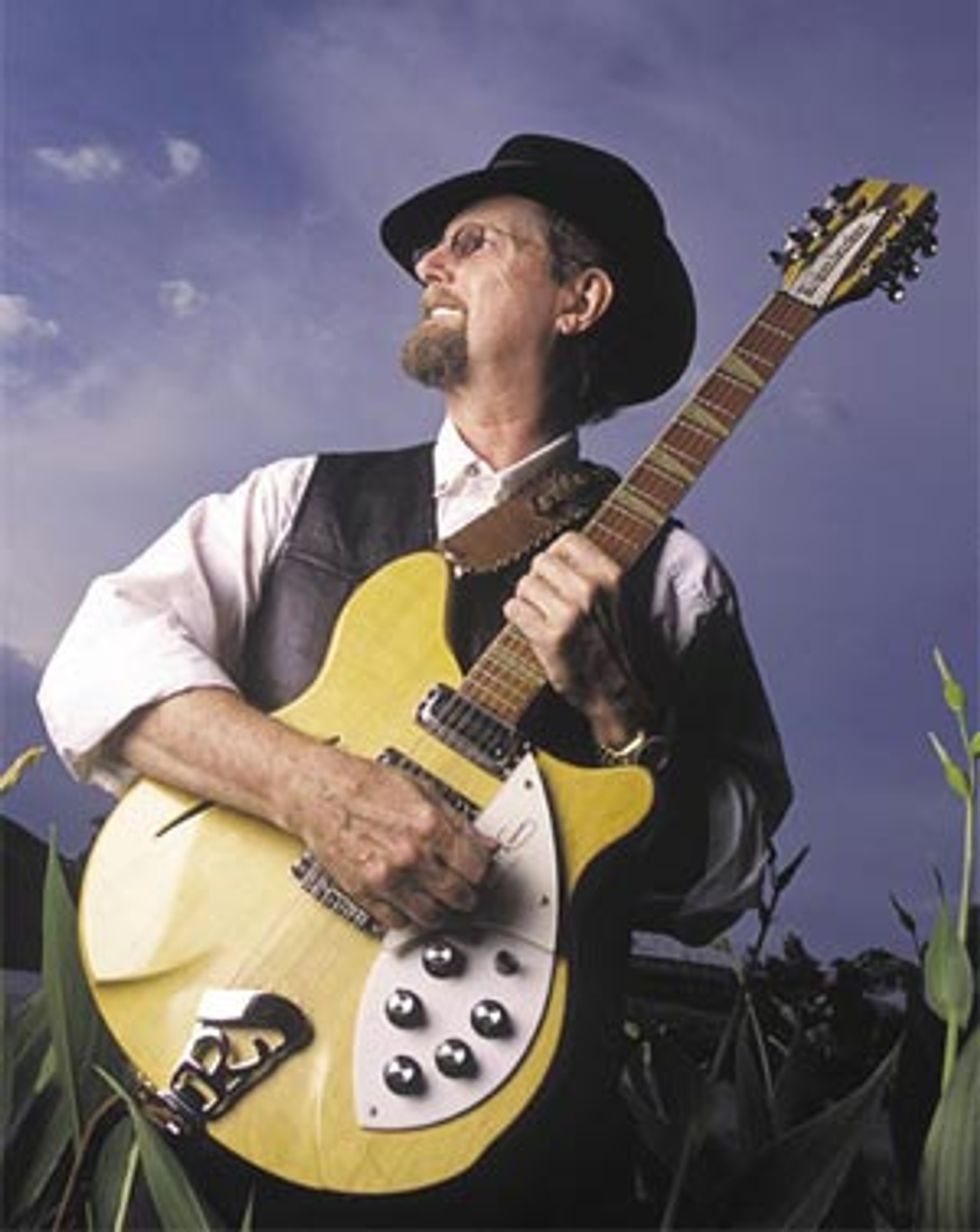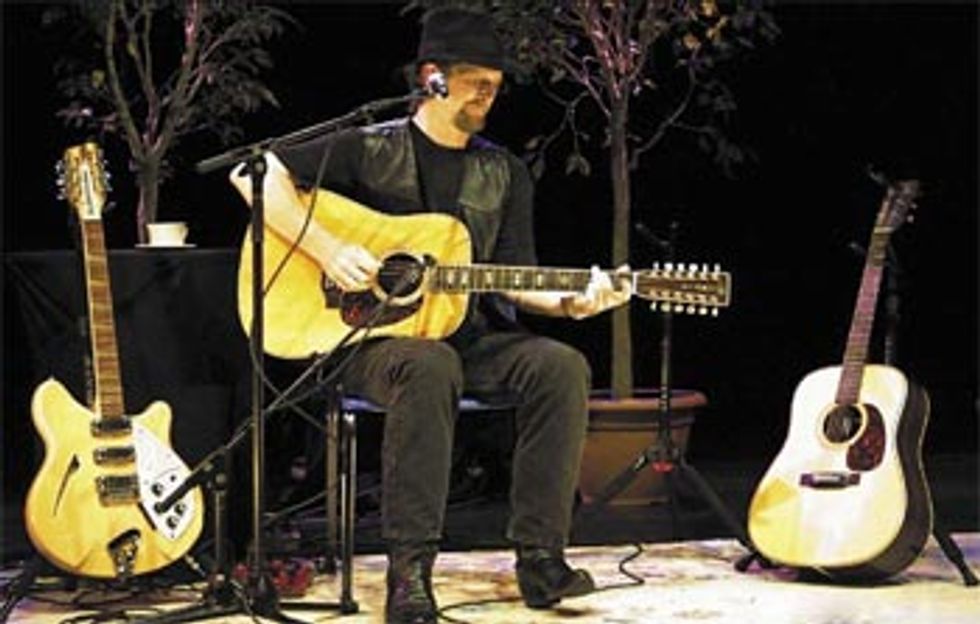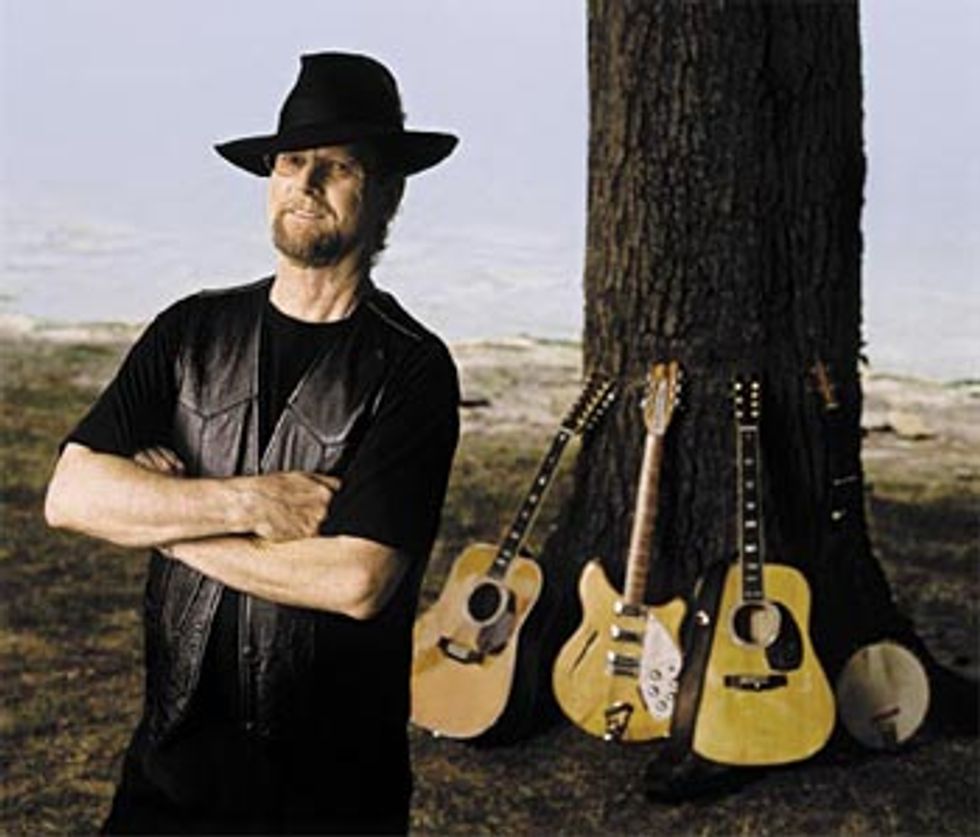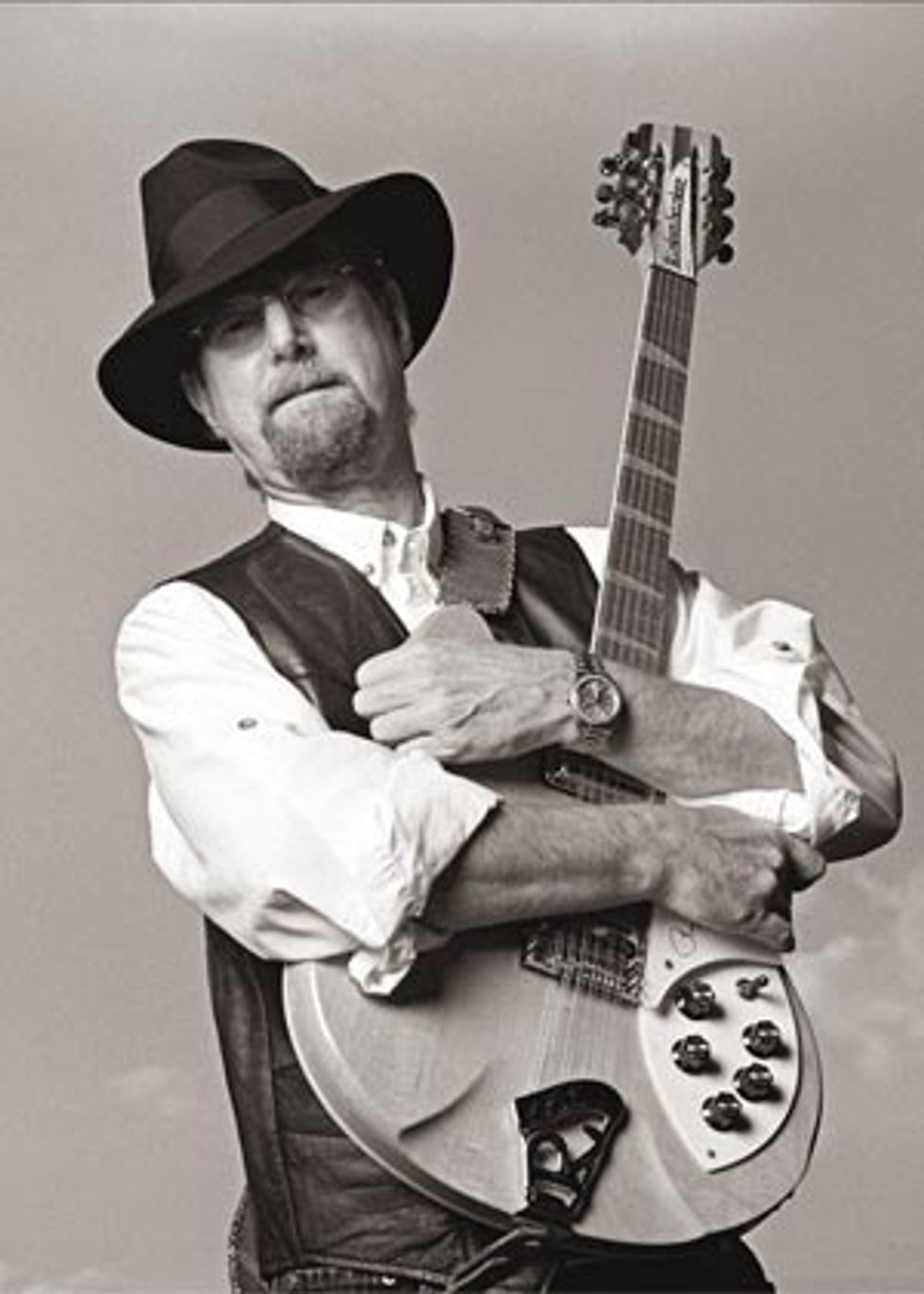An interview with Roger McGuinn, with notes from Rickenbacker''s John Hall and the Byrds'' Chris Hillman
|
After The Byrds broke up in 1973, Roger maintained an electric band until 1981, and then began performing solo and has been ever since. Now in his mid-sixties, Roger and Camilla, his wife/road manager, tour in a well-equipped van carrying only the essentials: several guitars, a banjo, and a few electronic devices (he’s always been a lover of gadgetry and collects vintage transistor radios) along with their personal belongings. McGuinn picks and chooses his gigs carefully, avoiding outdoor shows, clubs, bars and church venues. He continues to sell out shows wherever he plays—no simple feat for this folk/rock survivor and member of the Rock n’ Roll Hall of Fame. I questioned Roger extensively about a possible reformation of The Byrds. Although some of that conversation remains on the cutting room floor, McGuinn’s position is clear. He has no interest in putting the Byrds back together.
Let’s start by discussing your current stage equipment. What are you using right now?
All the guitars I use are signature models, such as the Rickenbacker 370/12/RM— similar to a triple pickup 370—a Martin D12-42/RM and Martin HD-7, the seven string model Martin designed with input from me. I also use a banjo that I got from Bernie Leadon, formerly of The Eagles, and in return I gave him a new Fender Mastertone banjo. It’s a combination of old Vega and Ode banjo parts. It’s one of the best banjos I’ve ever played. I took it to Pete Seeger’s house recently and he played it and gave it his stamp of approval.
You are most closely associated with the Rickenbacker 12-string. Would you tell us how you came to use that guitar in the early days of The Byrds? Also, what that guitar has meant to you as your sonic “signature” over the years?
We went as a group to see A Hard Day’s Night multiple times and were totally taken with The Beatles. I liked George Harrison’s Rickenbacker 12, but I couldn’t find one that looked like his with the pointy cutaways, so I bought the blonde 360 model. I thought it was beautiful, like a golden palomino and the checkerboard binding reminded me of Gene Autry or Roy Rogers. I loved that guitar and played it eight hours a day.
It was later stolen and I discovered that it was auctioned off in England for over $100,000. Given the statute of limitations and the difficulty in dealing with laws in a foreign country, there wasn’t much I could do, even though I considered myself the legal and rightful owner.
Your sound has always been marked by the use of compression on the Rick 12. You used to record directly into the board. What brand of compressor was it?
I don’t know what they used in the Columbia Studios, but I do know they were tube-driven. Using compression was the idea of Ray Gerhardt, one of the house engineers at Columbia. They had no experience working with rock n’ roll bands and were scared we’d blow out their equipment, so they used compression in an attempt to protect themselves! I know they were very nervous about recording us. [Author’s Note: Ray Gerhardt was an award-winning engineer, famed for his work on records by Percy Faith and other easy listening artists of the day.]
How did you recreate your compressed studio tone onstage back in the days when stompboxes were in their infancy?
I never did. Paul Kantner of Jefferson Airplane, who also played a Rickenbacker 12, turned me on to the Vox Treble Booster in 1966. I took the Rick apart and installed it in the guitar. It really was an outboard box that gave me some gain, but no compression. Later, we got a rack compressor that we used on gigs, but in the early days, I couldn’t get compression onstage until we got that rack. I tried all the compressors available, including the Dyna-Comp and the Boss, but didn’t like any of them. Not until Rickenbacker designed my signature guitar with the built-in compressor, did I find one that worked for me.
Were you involved in the design of your onboard compressor?
No, an engineer from Rickenbacker designed it. He left shortly after and went to work for Fender, I think. John Hall could tell you who he was. [Author’s Note: See John Hall sidebar.]
When Rickenbacker stopped producing your signature guitar, that compressor was discontinued along with the guitar. I’m surprised they never marketed a stompbox version of it.
It was the best sounding compressor I ever used until the Janglebox came along. I suppose it was because Rickenbacker is not in the effects business. I did the entire Back From Rio album with that Rick compressor. The Janglebox is now the bestsounding compressor on the market in my opinion—I use it all the time. It’s clean and quiet, and it sounds very close to the built-in one I have in the 370/12/RM. As far as that guitar goes, they produced a thousand and sold every one. John Hall won’t reissue it because he wants to keep the collectible mystique alive, I suppose, but I wish he would reissue it.
Rickenbacker 12-strings have always been finicky instruments. I own a ’92 330-12 with “toaster” pickups with an Amber Fireglo finish. Do you do your own setups and adjustments?
Yes, I do. If you check out my video, The 12 String Guitar of Roger McGuinn on Homespun Tapes, I demonstrate how to do your own neck and action adjustments and string changes.
Although you are most often associated with the Rick 12, you played other guitars with The Byrds. Can you tell us about those instruments and why and how you used them?
I had a Gretsch Country Gentleman strung with flatwound strings that I used on “Have You Seen Her Face”—that was The Beatles’ influence again.
I could have sworn that was a Telecaster.
No, it was a Gretsch. After Fender was taken over by CBS, we got a ton of Fender gear. They gave me a Mastertone banjo, which is the one I traded to Bernie, an electric 12-string that I used in the studio, an acoustic guitar and a Telecaster. I used the Gretsch a lot around the time Gram Parsons was in the band and we recorded Sweetheart Of The Rodeo. The Rickenbacker really didn’t fit too well with the country music we were playing.
I remember seeing you with your later band Thunderbyrd in the mid-seventies, and you played a Rickenbacker Light Show guitar on “Eight Miles High.” Do you still have it? What was it like to play?
I have two of them and they’re fun guitars. The first one I have is no longer in playing condition, but the second one is in pretty good shape. However, I don’t use either of them anymore.
You also had a Rickenbacker Bantar, didn’t you? That was their hybrid instrument that combined a banjo and a guitar, right?
Yes. I actually took that on loan and sent it back. I tried it for a little while, but it wasn’t very useful.
Do you have any other interesting guitars we should know about, and do you consider yourself a collector?
I’m not a collector, but I do have a very nice ’57 Martin 00-21 that I paid $165 for. I’m not permitted to say how many Rickenbackers I own.
How did your signature Martin seven string come about?
Air France broke one of my acoustic 12-strings, so I wanted to condense the characteristics of a six and twelve string into one guitar. We designed a prototype on napkins over lunch and Martin put it into production. It’s now available in a less expensive version. I call it the “Swiss Army Knife” of guitars. It gives me nice bottom end tone, and it’s easy to do bluegrass runs and bend strings.
Over the years, what amps have you used?
In early days of The Byrds, I used an Epiphone with two 10. speakers. We went direct in the studio. Later on, we used Fender Dual Showman amps for live work, which we liked a lot. John Sebastian turned me on to the Roland JC-120, and that was my amp of choice for years. Although it’s a great-sounding amp, I go direct onstage. I use an in-ear monitor and AM wireless. In fact, I start my show offstage, so you can hear me, but not see me. I plug into a Sennheiser wireless, into the Janglebox and then a direct box.
How do you view The Byrds today, after years as a solo artist? When you look back over your time with the band, what are your thoughts and feelings about those days?
It was a lot of fun. We left a great legacy of music. I hear new, young bands all the time that are influenced by The Byrds’ music.
Do you think the music holds up well?
Yes, it does hold up quite well. I’m amazed at the young kids I meet who are into the Byrds’ music, people in their twenties—hippie kids you might say, who like the band.
What are your favorite Byrds tracks?
“Renaissance Fair,” “Time Between,” “Have You Seen Her Face,” “Turn! Turn! Turn!,” “Mr. Tambourine Man” and “So You Want To Be A Rock ‘n Roll Star.” There are a lot of favorites.
Are there any you’d like to forget?
If there are, I’ve forgotten about them! [laughter on both ends]
The Byrds went through many stylistic and personnel changes and pioneered folk rock, psychedelic rock, country rock and even space rock. Which version of the band was your favorite and why?
I don’t have one favorite, but the first version of the band with Gene Clark, David Crosby, Chris Hillman and Michael Clarke was special. We had no money, no day jobs; we were almost starving, but then we had a number one hit with “Mr. Tambourine Man,” and everything took off from there. It was an amazing acceleration to go from nothing to number one. I also liked the later version of The Byrds with Clarence White.
Let’s do a little name association. David Crosby:
Great harmonies.
 Chris Hillman:
Chris Hillman: Multi-talented.
Gene Clark:
Wonderful songwriter.
Michael Clarke:
Looked like two of The Rolling Stones.
Clarence White:
Incredible genius.
John Lennon:
A way with words.
George Harrison:
Loved his guitar work.
Bob Dylan:
Great songwriter
You have toured as a solo artist since 1981, but do you ever miss working with a full band?
I play with The Rockbottom Remainders, a band that includes Stephen King, Amy Tan, Dave Barry, Ridley Pearson, Mitch Albom and other writers. We do about 3- 5 charity gigs a year and have a lot of fun doing it. The name of the band pertains to the reject books in the bargain bin that no one wants. I have also gone out occasionally with a trio of Dave Matthews on bass [Author’s Note: Not singer/songwriter Dave Matthews] and Paul Eaton on guitar and banjo.
I saw The Byrds’ version of “Mr. Tambourine Man” on YouTube that was recorded at the Roy Orbison PBS tribute show, and your harmonies with Bob Dylan were so moving. They went straight to my heart. Was Dylan’s walkon appearance planned ahead of time, or did he just stroll onstage on a whim?
That was a pretty cool night. We definitely flew by the seat of our pants! No, Bob’s entrance was planned beforehand. We discussed it backstage in the dressing room. He missed his cue to come out. They had to go find him, I guess, so that’s why he was late entering the stage. Bob is always a delight to work with.
Now, the question I have been waiting to ask you for years: why no Byrds reunion? Chris Hillman has stated that he would do it, and I know Crosby would too.
Chris used to go back and forth on it. When he talked to David he agreed with him. When we talk now, he agrees with me that we shouldn’t. We have a wonderful backlog of songs—a great legacy so why mess with it? I certainly wouldn’t do it for the money. We did another benefit in 2000 with Bonnie Raitt, Jackson Browne and Graham Nash. I’m having too much fun as a solo artist to go through all that again.
You wouldn’t have to do a whole tour, Roger. Would you consider doing just two shows, one on the west coast and one in New York City, just for the fans?
You have our music, your memories and our old film clips on YouTube.
You’ve been releasing your own recordings for years without a record deal and that seems to be the trend today and most likely for the future. What are your feelings on the current state of the music industry?
After I did Back From Rio on Arista, I turned down other record deals because the record industry’s business model is broken. One record executive commented, “I didn’t know Roger McGuinn was so smart.”
Having my own label was something I wanted to do for years. We’ve released several CDs, but I think the record business, i.e. the major labels, are doomed to a slow and painful death. They’re dinosaurs. They loan you a million bucks with advances to keep you in debt, so you never make any royalties. Most bands make their money on live gigs and merchandise and always have.
I never saw a penny in royalties from Arista on Back From Rio, and it sold over a half million copies. I made more money on the Limited Edition CD I released myself than I ever did from them. All a young band needs today is MySpace, Facebook, a website and a blog. They can cut their own CDs with Pro Tools and a Mac and sell them over the Internet or at gigs. You don’t need a record label throwing money your way anymore.
Unfortunately, this trend has also put a lot of recording studios out of business, and that’s a shame.
You’ve always been a fan of gadgetry, so it’s no surprise that you latched onto the internet early on. Do you ever frequent websites dedicated to the Byrds or Rickenbacker guitars?
Once in a while I used to visit forums like allbyrdsmusic.com a lot in the nineties, but things started getting ugly on there.
Any thoughts of slowing down your gig schedule? Is touring and performing still exciting and fulfilling for you?
Not at all, and yes, I still love performing. I’ve stopped doing clubs, bars, outdoor festival-type gigs and church gigs, but I’ll only play theatres and performing arts centers because they’re always well-equipped facilities. It’s still very enjoyable for me to go out and play for people. I travel with my wife and we have friends and fans all over the country. I sell out everywhere and plan to play for the rest of my life.
| John Hall on Roger McGuinn and his Signature Rickenbacker |
I met him in 1965 at The Beatles’ rented house in Hollywood after their Hollywood Bowl concert. That was a real thrill for me. I was fifteen and Roger had several years on me. We became friends and have always had a very cordial relationship. We had a great time building his signature guitar.
 Can you tell me how and when the 370/12/RM was developed?
Can you tell me how and when the 370/12/RM was developed? I think it was 1988. I contacted Roger to do a limited edition guitar. We had just done the Pete Townshend limited edition, and doing a 12-string with Roger was a natural thing. He had been associated with the Rickenbacker 12-string for so many years. Essentially, we worked together to produce Roger’s dream instrument. He chose features from his standard 370 three pickup model, plus other improvements and upgrades, such as the onboard compressor.
Who designed the compressor in Roger’s guitar?
That was our chief engineer, Bob Desiderio. He left shortly after and went to work for Fender, and I believe he’s still there. Bob also designed the pickups and circuitry for John Kay’s signature model.
I wondered why Rickenbacker never issued the McGuinn compressor as an outboard stompbox?
It wouldn’t have been right to offer something like that after a limited edition guitar had gone out of production.
Any chance you might reissue the 370/12/RM anytime in the future?
Not at the moment. We’re already way behind in our production schedule as it is. We don’t have the manpower to put limited edition reissues into production. I really don’t like reissuing signature guitars, to be honest. It defeats the purpose of an instrument being a limited edition. If Roger wants to work with us to produce a new instrument sometime down the road, we could do that.

| Chris Hillman on Roger McGuinn & The Byrds |
Chris Hillman was the original bass player with The Byrds and also played with Roger McGuinn in the group McGuinn, Clark & Hillman. Chris has worked with Gram Parsons in The Flying Burrito Brothers, with Stephen Stills in Manassas, with the ill-fated super-group Souther, Hillman & Furay, and as a solo acoustic and electric artist. Hillman enjoyed considerable mainstream country music success with The Desert Rose Band in the nineties, and still tours, playing mandolin and flattop acoustic guitar with his musical partner, Herb Pederson. They play an acoustic bluegrass-inspired music. I chatted with Hillman briefly about Roger McGuinn and The Byrds.
How would you describe your relationship with Roger McGuinn?
Roger and I are still friends, in fact, I emailed him for his birthday recently and said we should have lunch and catch up, but of course, he lives in Florida now. I can tell you that Roger was easily the best musician in The Byrds. He’s an extremely talented and meticulous man, and I have nothing but respect for him and always have. Although I enjoy what he’s doing now, I think he’s the type of musician who needed and still needs a catalyst to bring out the best in him. I believe I was that catalyst in The Byrds. He and I finished the Notorious Byrd Brothers album ourselves.
Roger told me point blank that he wouldn’t reform The Byrds. As a lifelong Byrds fan, it would be great to see the three surviving original members together onstage again before I leave this earth.
You’re not going to see it. I totally agree with Roger that we should leave it alone. The Byrds left a great legacy of music and it should remain that way. Besides, both Michael Clarke and Gene Clark are dead, and we both feel the band should be remembered as the Photo: © Bill Kollar five original members.
| Roger’s Gearbox On the road and in the studio:
|
Roger McGuinn
rogermcguinn.com

